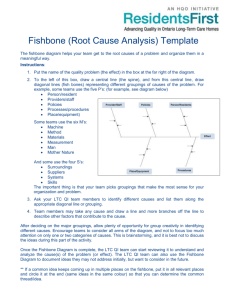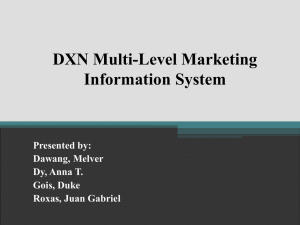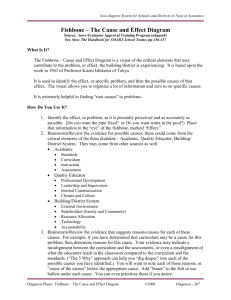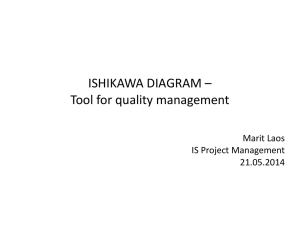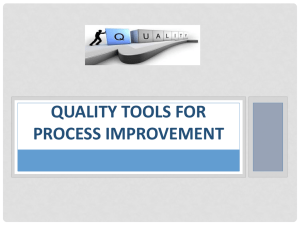lt_Fishbone_Diagram_lp
advertisement
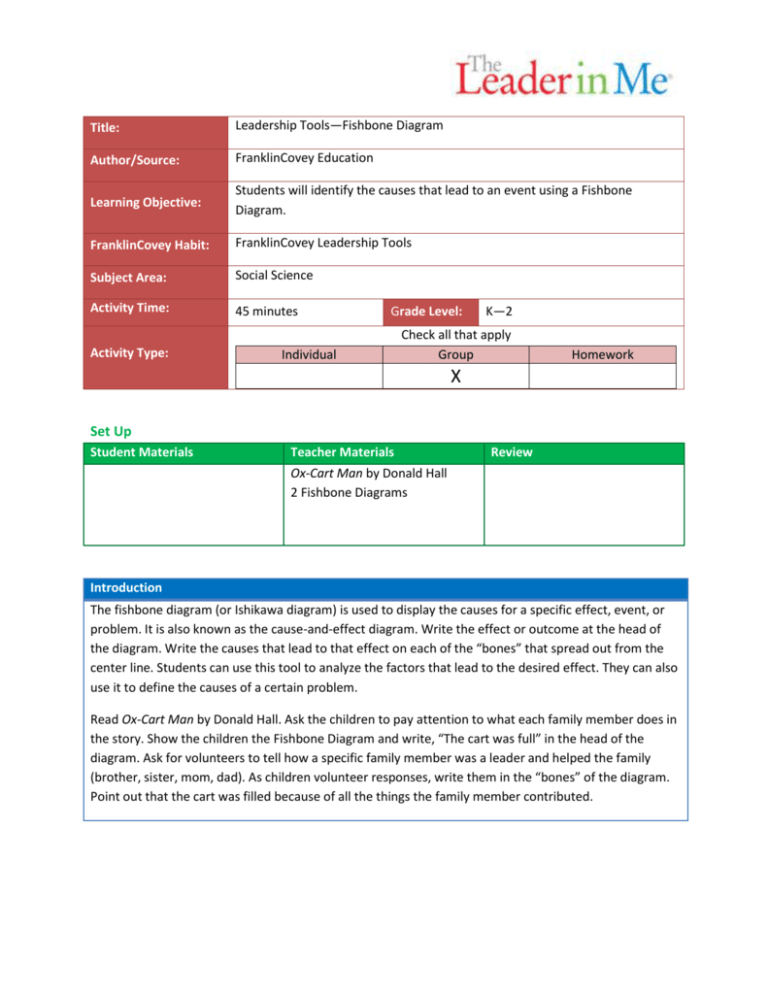
Title: Leadership Tools—Fishbone Diagram Author/Source: FranklinCovey Education Learning Objective: Students will identify the causes that lead to an event using a Fishbone Diagram. FranklinCovey Habit: FranklinCovey Leadership Tools Subject Area: Social Science Activity Time: 45 minutes Activity Type: Individual Grade Level: K—2 Check all that apply Group Homework X Set Up Student Materials Teacher Materials Ox-Cart Man by Donald Hall 2 Fishbone Diagrams Review Introduction The fishbone diagram (or Ishikawa diagram) is used to display the causes for a specific effect, event, or problem. It is also known as the cause-and-effect diagram. Write the effect or outcome at the head of the diagram. Write the causes that lead to that effect on each of the “bones” that spread out from the center line. Students can use this tool to analyze the factors that lead to the desired effect. They can also use it to define the causes of a certain problem. Read Ox-Cart Man by Donald Hall. Ask the children to pay attention to what each family member does in the story. Show the children the Fishbone Diagram and write, “The cart was full” in the head of the diagram. Ask for volunteers to tell how a specific family member was a leader and helped the family (brother, sister, mom, dad). As children volunteer responses, write them in the “bones” of the diagram. Point out that the cart was filled because of all the things the family member contributed. Activity While the children are still in a group, display the blank Fishbone Diagram. Write in the head of the diagram, “Ready for school”. Ask for volunteers to tell what they do at night to be ready for school the next day. Write the responses in the Fishbone Diagram. If needed, additional boxes may be added. Wrap Up As the activity nears the end, discuss how each of the “bones” helps make the head of the diagram happen. They are the causes. Assessment Student participation will determine understanding. Extensions & Integrations A Fishbone Diagram can be used in behavioral situations to discuss the causes that lead to a problem. Title: Leadership Tools—Fishbone Diagram Author/Source: FranklinCovey Education Learning Objective: Students will demonstrate use of a Fishbone Diagram. FranklinCovey Habit: FranklinCovey Leadership Tools Subject Area: Social Science Activity Time: 45 minutes Activity Type: Individual Grade Level: 3—6 Check all that apply Group Homework X Set Up Student Materials Teacher Materials Fishbone Diagram for each group Whiteboard or Chalkboard. of four-five students. Review Introduction The fishbone diagram (or Ishikawa diagram) is used to display the causes for a specific effect, event, or problem. It is also known as the cause-and-effect diagram. Write the effect or outcome at the head of the diagram. Write the causes that lead to that effect on each of the “bones” that spread out from the center line. Students can use this tool to analyze the factors that lead to the desired effect. They can also use it to define the causes of a certain problem. Draw a large Fishbone Diagram on the board. Ask, “What do you think this looks like?” Allow for student input. Say, “A Fishbone Diagram is used to show the causes leading to a specific effect or event. The causes are written on the ‘bones’ of the diagram and the effect/event is written in the ‘head’ of the diagram. We are going to use the Fishbone Diagram today to think about the causes of a cooperative classroom.” Give each student a number or playing card that will be used in the Wrap-Up section. Activity Put the students in groups of four-five and give each group a Fishbone Diagram. Have one student write, “A cooperative classroom” in the head of the diagram. Allow students approximately 15-20 minutes to determine what needs to happen in a classroom (the causes) to lead to a cooperative feeling in the class. Wrap Up Bring the class back together to share the groups’ Fishbone Diagrams. Draw a number or playing card from the deck and have that student from the group explain the group’s diagram. By randomly seeking volunteers, each member of the group needs to be prepared. Assessment Student diagrams and explanations will determine understanding. Extensions & Integrations A Fishbone Diagram is an excellent tool and unique way to explain an event in history.

